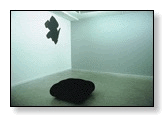Chris Fortesque
21/07/11 10:06
Ipso Photo
The Centre for
Contemporary Photography
Melbourne, 1994
Susan Fereday & Stuart Koop

Chris Fortesque, untitled, 1994
Ipso Photo is a photography exhibition without photographs; instead it is of or derived through photography (ipso - by, through). It considers the enduring influence of photography on non-photographic artforms. In particular, it aims to locate some recent installation and sculptural work in relation to current debates about photography. |
|
A burgeoning dialogue is currently occurring between photographic representation and non-photographic artforms, such that traditional definitions of photography as material print no longer seem adequate to account for its widescale influence within the visual arts. There seems to be a preoccupation with the procedures of photography quite apart from the final image. Photographic historian and theorist Geoffrey Batchen has identified this tendency as part of a ‘post photographic’ scenario in which ‘the boundary between photography and other media like painting, sculpture and performance has become increasingly porous’. Batchen argues that each medium has ‘absorbed the other, leaving all irreparably changed’.
1
This inevitably leads to the confusion of distinctions and definitions of media, and subsequently, to a more general definition of photography which supports its recent, wide-ranging applications.
|
For example, conceptual and spatial relations in recent installation work are often shifted through photographic characteristics such as single point perspective, differential focus, colour casts and ambiguities of scale. This is true of recent work by the artists in Ipso Photo and many others besides. Increasingly, the current influence of photography within installation practice can be identified beyond the photograph per se – that is, beyond the mere two dimensions of flat representation – and in the configuration of gallery space according to the model and characteristics of photography.
Chris Fortescue
remarks of his recent installations that photography provides a ‘framework through which all of the relationships in the work, and between the work and the audience, are articulated’. And Margaret Roberts describes her installations as if ‘set up by or through a camera’. What definition of photography is sufficient to these descriptions and practices?
In Chris Fortescue’s work the wall and floor are demarcated according to standard interior hues; a sky blue wall and a salmon carpet. An illdefined blob on the wall corresponds to a deep blue velour cushion sitting on the carpet; they are positioned within their respective fields of colour according to the same co-ordinates. Like a box camera, the two fields appear to replicate each other; one reflecting the other across 45 degrees. Yet the evident mutation of form and colour suggests, once again, the transformative potential between these quasi-photographic planes. Another reference is perhaps made to the social space of photogaphy’s reception. It’s as if the debate about photographic representation - the critique of its objectivity and accuracy - had leaked out of the image and seeped into quotidian forms, such that the domestic environment of the photograph is suffused with the formal and symmetrical relations which produce the image. Fortescue describes these tableaus as ‘setting up a paradox’ between ‘sensation’ and ‘representation’. Effectively, Fortescue’s work operates in the reverse direction from the other work in Ipso Photo; from everyday space back to representational space. And so the contrast between these two kinds of space is experienced in a different register, not so much in the illfit of rigid and imposed photographic geometries, but in a resounding domestic oddity or weirdness. The body is caught between its sense of homely abandon and formal occasion; precisely between repose and pose.
...
Susan Fereday and Stuart Koop
1994
Endotes
1. Batchen, G., ‘On Post-Photography’, Afterimage, vol.20 no.3, October 1992, p.17
2.Barasch, M., Theories of Art from Plato to Winckelman, New York University Press, New York, 1985, pp.148-59
3. Burgin, V., ‘Photography, Fantasy, Fiction’, Screen, vol.21 no.1, Spring 1980, p.51
| What's on at Gorman House |
Chris Fortescue
May 27 until June 27 1993.
Presented by Canberra Contemporary Art Space.
At Gallery 1, CCAS, Gorman House Arts Centre.
Chris works with combinations of discrete objects and images,
negotiating the signifying practices of 'installation' and 'style' within an art context.
Contact CCAS on 2470188.


7 March - 13 April 1997
Chris Fortescue: Gentle Hour Unsung
Shaun Kirby: International Headache Congress Both Chris Fortescue (Sydney) and Shaun Kirby (Adelaide)
created separate three dimensional environments which responded to the characteristics
of the gallery space and presented ambiguous meanings for the viewer.




